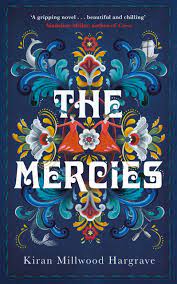I’d seen this book here, there and everywhere over the last year or so. At first, I lumped it in with that slew of novels, all with a similar style of colourful, swirling patterns on the cover and a one-word title, that were so much in vogue in the last year or so. You know the ones I mean – The Familiars, The Foundling, The Binding, The Corset. I tried all of those, having a love of the gothic, but didn’t finish any of them. I found them pale imitations of the real thing, compared to, say, one of the early Sarah Waters books. The other thing that put me off trying this one, for quite a long time, was Millwood Hargrave’s children’s novel, The Girl of Ink and Stars.

Despite it’s wonderful title (a title that, incidentally, put paid to my own novel, The Girl with Stars in her Hair) I found myself a little underwhelmed by the book. It was Ok, I suppose, but no where near as good as I had been led to believe. If you’re a big fan of that particular book, don’t take offence – I know I’m not in the mainstream with this opinion and that many people loved it. It just didn’t work for me.
So, for these reasons I had avoided The Mercies. But then, by chance browsing in my excellent local library (yes, they still exist) I came across a pristine edition of the book. Unstamped and with a gleaming plastic jacket, it looked so tempting on the shelf that I took it out on a whim, just in case. And how glad I am that I took a punt on it. What a book! Exquisite, beautiful and troubling in equal measure, it’s one of the best books I’ve read for a long time.
It’s set in the early Seventeenth century in a remote part of Northern Norway called Finnmark. Or, more precisely, on a wild and barren island just off the coast of Finnmark called Vardo in a community of fishermen and their families. It’s based on a real set of historical events from that time, when the entire male population of the island was killed just after they set out to sea on a fishing trip. Minutes after they departed, a freak storm of terrifying strength sprang up and within view of the island all the ships were sunk and everyone was drowned. The women of the island had to take on all of the men’s work to survive, so they learned to fish and were able to support themselves. This will to survive, in opposition to the religious orthodoxies of the time with regard to women’s station in life, sowed the seeds of the tragic conclusion to the story. It was their misfortune to be finding their voice at a time when the King of Norway, Christian IV was wanting to make his mark on history by enforcing strict Protestant compliance across the country. This desire clashed with two other factors: The presence of the Samii community who had their own much misunderstood religious beliefs and practices, and the wave of witch burning that took place across Europe, particularly in Scotland.

Christian IV installs a Scottish witch finder, John Cunningham, who had had much feted success in witch hunting, trials and executions in Scotland, where the climate had been set by King James’ own study of witchcraft, “Daemonology”. He arrives with his new young wife Ursa, from cosmopolitan Bergen, who is distraught at the utterly bleak landscape both of Vardho and of her marriage to her domineering religious zealot of a husband. The women of Vardho fall into two camps: those who flourished taking on male roles and responsibilities and the more conservative traditionalists. The traditionalists are courted by Cunningham and begin to betray their more liberal fellow villagers, falsely reporting them for all manner of dubious practices. Families are divided as the most innocent signs, particularly of the Saami culture, which had been adapted over the years by the Norwegians are used as proof of witchcraft.

As Cunningham’s work moves inexorably towards its grisly conclusion, Millwood Hargrave portrays a growing love that develops between Ursa and Maren, one of the island’s widows. It’s beautifully done, with prose that is restrained and elegant. It’s obvious for all to see that Millwood Hargrave is a poet of considerable gifts. The impending tragedy is rendered in unsparing detail and the savagery of religion and man’s capacity for inhuman behaviour towards their fellow man (or woman in this case) set against a doomed love story is almost unbearably moving.
The only thing that jarred for me was the sense of time. The sense of place was very powerfully done: the terrain, the weather and the customs – all unremittingly bleak- are very convincing, but I didn’t feel the same way about the sense of historical period. Despite the references to Daemonology and the witch trials of James IV, I was not struck by this book as being of the Seventeenth century. There was a general sense of it being set in The Olden Days (or “Yore” as Rachel from Friends had it), but nothing more specific than that.
Perhaps I’m splitting hairs – and it wouldn’t be the first time, Your Honour. This is a wonderful book, and would be great for anyone doing Macbeth, student or teacher, to read, to get a bit of background to the play. I will go back and have another go at The Girl of Ink and Stars, but even if that does not change my mind, I don’t think Millwood Hargrave should lose much sleep over it. She is going to be a great writer, I think, and I can’t wait for her next book for adults.